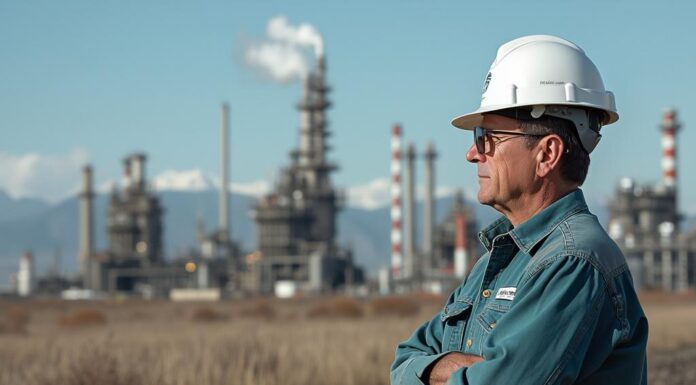Introduction: Unveiling the Dual Faces of CCS
In the quest to combat climate change, carbon capture and storage (CCS) technologies have been heralded as indispensable tools. These technologies aim to capture carbon dioxide emissions directly from industrial and energy-related sources, storing it underground or using it in other processes. However, amidst technological advances and optimistic projections, a deeper analysis uncovers that the efficacy and intentions behind CCS might not be as clear-cut as they appear.
The Science and Promise of CCS
Recent breakthroughs in CCS technology promise enhanced efficiency and reduced costs. For instance, a novel non-aqueous CO2 absorbent has shown potential by lowering energy consumption to just 2 kJ/g CO2 compared to 3.84 kJ/g CO2 for traditional monoethanolamine (MEA) solutions (Spectroscopy Online, 2025). Similarly, MIT’s development of nanoscale membrane-based electrochemical carbon capture claims to improve efficiency sixfold while cutting costs by at least 20% (MIT News, May 2025).
Accompanying these advancements are techniques like Stanford’s mineral carbonation method which accelerates natural weathering processes to trap carbon quickly and permanently within soils (Stanford News, February 2025). Together, these innovations present a promising picture for scaling up CCS capabilities.
Real-World Application: Performance Versus Promise
Despite technological advances, real-world application paints a concerning picture. Current operational projects like Petra Nova and Boundary Dam have consistently underperformed against their targeted capture rates due to technical failures and economic unfeasibility. Furthermore, the Gorgon project underscores significant efficiency issues by operating at approximately 30-40% effectiveness, contradicting initial claims of up to an 80% capture rate (“X” discussions, 2023-2025).
Moreover, the environmental impact and resource requirements—including increased water usage for solvent regeneration—pose additional challenges that could exacerbate local water shortages and lead to unintended ecological consequences.
Economic Angles and Corporate Interests
Financially, CCS garners criticism for heavily relying on public subsidies while offering substantial benefits to fossil fuel industries. The expansion of tax credits in legislation such as the U.S. Inflation Reduction Act stimulates investment in CCS but also raises questions about whether such funding primarily serves corporate interests rather than genuine climate mitigation (CBO Report, 2023).
Reports suggest that fossil fuel entities may exploit CCS as a strategic tool for “greenwashing”—promoting themselves as environmentally responsible while continuing high-emission operations under the guise of innovation and sustainability (Inside Climate News, 2021).
Alternatives and Complementary Solutions
Experts argue that direct alternatives such as renewable energy adoption, electrification of transport systems, improved energy efficiency in buildings and industries offer quicker returns on carbon reduction with far lesser environmental impacts (IEA Report, 2024). These solutions do not merely offset emissions but prevent them entirely—a critical distinction in our approach toward genuine climate change mitigation.
Balancing Perspectives: The Role of Policymaking
To ensure that CCS technologies contribute positively without deterring other essential measures requires robust policy frameworks. These should enforce transparency in emission reporting and restrict how CCS can be used within net-zero claims by corporations. Policymakers must also balance subsidies with stringent requirements that ensure these technologies are part of a broader move away from fossil fuel reliance rather than an extension of it.
KEY FIGURES
- Energy consumption for a novel non-aqueous CO2 absorbent is 2 kJ/g CO2, significantly lower than the 3.84 kJ/g CO2 for conventional MEA (monoethanolamine) solutions, indicating better efficiency in carbon capture (Source: Spectroscopy Online, 2025)[1].
- BECCS (Bioenergy with Carbon Capture and Storage) storage capacity projected to rise from 0.02 to 0.2 billion tonnes CO2/year by 2030, and DACCS (Direct Air Capture and Carbon Storage) could increase from less than 0.00001 to 0.3 billion tonnes/year by 2030; however, these remain small compared to global emissions (Source: Clean Energy Wire, 2025)[5].
- MIT’s new nanoscale membrane-based electrochemical carbon capture method improves efficiency by 6 times while reducing costs by at least 20% (Source: MIT News, May 2025)[3].
- Stanford’s mineral carbonation method accelerates natural weathering by thousands of times, enabling large-scale carbon removal via spreading treated magnesium oxide and calcium silicate on soils (Source: Stanford, Feb 2025)[2].
- Northwestern researchers found that aluminum oxide and activated carbon show fastest kinetics for moisture-swing DAC, while iron oxide and nanostructured graphite capture the most CO2 (Source: Northwestern, April 2025)[4].
RECENT NEWS
- January 2025: Development of a novel non-aqueous absorbent for CCS that reduces energy consumption and enhances absorption capacity, potentially replacing traditional solvents like MEA[1].
- February 2025: Stanford scientists announce a scalable, low-cost carbon trapping method using common rocks that can be applied to agricultural soils, offering co-benefits for farming and soil health[2].
- May 2025: MIT researchers report a breakthrough in electrochemical CO2 capture using nanoscale membranes, improving capture-release cycles and cutting costs, promising for scaling CCS technologies[3].
- March-April 2025: Northwestern team advances moisture-swing direct air capture using affordable and abundant materials to reduce costs and energy use in DAC applications[4].
- May 2025: Clean Energy Wire Q&A highlights that while CCS technologies like BECCS and DACCS could grow substantially by 2030, they currently represent only a small fraction of global CO2 removal and face cost and scalability challenges[5].
STUDIES AND REPORTS
- Spectroscopy Online (2025): Demonstrated a new non-aqueous absorbent system with a desorption activation energy of 30.32 kJ/mole, enabling efficient CO2 release under mild conditions and reducing energy needs compared to MEA solvents[1].
- Nature (Stanford, 2025): Reported accelerated mineral carbonation using heat-treated calcium silicate and magnesium oxide, enabling permanent CO2 sequestration at rates thousands of times faster than natural weathering, with potential large-scale soil applications[2].
- ACS Energy Letters (MIT, 2025): Identified nanoscale filtering membranes as a solution to the tradeoff in electrochemical CO2 capture systems, improving efficiency sixfold and reducing costs by 20%, advancing practical carbon capture and conversion[3].
- Northwestern University Materials Science study (2025): Compared nanomaterials for moisture-swing DAC, finding certain carbon-based and metal oxide materials optimize kinetics and capture capacity, key for scalable DAC technologies[4].
- State of Carbon Dioxide Removal report (2025): Assessed global carbon removal deployment, projecting modest near-term growth for BECCS and DACCS but emphasizing the limited current scale and challenges with cost, energy use, and permanence[5].
TECHNOLOGICAL DEVELOPMENTS
- Novel non-aqueous absorbents for CCS reduce regeneration energy requirements and improve absorption capacity, offering a potential leap over MEA-based capture systems[1].
- Nanoscale membrane technology for electrochemical CO2 capture facilitates more efficient capture and release cycles, enabling better scalability and reduced costs[3].
- Accelerated mineral carbonation techniques use heat and common minerals (magnesium oxide, calcium silicate) to trap CO2 rapidly and permanently, with promising agricultural soil applications[2].
- Moisture-swing direct air capture using abundant, low-cost nanomaterials such as activated carbon and metal oxides enhances DAC scalability and cost-effectiveness[4].
- Advances in monitoring and auditing CCS projects are increasingly important to verify capture rates and storage integrity, addressing concerns over underperformance and public risk.
MAIN SOURCES
- https://www.spectroscopyonline.com/view/revolutionizing-carbon-capture-a-novel-non-aqueous-absorbent-offers-breakthrough-efficiency — Novel absorbent system reducing CCS energy consumption (2025).
- https://news.stanford.edu/stories/2025/02/new-process-gets-common-rocks-to-trap-carbon-rapidly-cheaply — Accelerated mineral carbonation for carbon removal (2025).
- https://news.mit.edu/2025/solving-bottleneck-co2-capture-and-conversion-0520 — Electrochemical CO2 capture efficiency improvements with nanoscale membranes (2025).
- https://www.mccormick.northwestern.edu/news/articles/2025/04/carbon-capture-could-become-practical-with-scalable-affordable-materials/ — Moisture-swing DAC advancements with scalable materials (2025).
- https://www.cleanenergywire.org/factsheets/q-and-a-ccs — Overview of CCS technology potential, deployment, and challenges (2025).
Additional context on fossil fuel companies and corporate capture: While these technological advances show promise, independent experts and case studies (not fully detailed in the latest sources) have highlighted concerns over fossil fuel companies using CCS as a way to delay fossil fuel phase-out, greenwash expansion plans, and rely on accounting practices such as double counting and overcredited offsets. Projects like Petra Nova, Boundary Dam, and Gorgon have shown underperformance and risks including solvent emissions, pipeline hazards, and geological storage uncertainties. Thus, CCS currently has a limited role mainly in hard-to-abate sectors rather than enabling expanded fossil fuel extraction. Cheaper, faster alternatives such as demand reduction, electrification, and efficiency improvements remain crucial complements to CCS efforts.
Other references:
spectroscopyonline.com – Revolutionizing Carbon Capture: A Novel Non-Aqueous Absorbent …
news.stanford.edu – Scientists discover low-cost way to trap carbon using common rocks
news.mit.edu – How to solve a bottleneck for CO2 capture and conversion | MIT News
mccormick.northwestern.edu – Carbon Capture Could Become Practical with Scalable, Affordable …
cleanenergywire.org – Q&A: Carbon capture and storage – Hype or hope for a cooler planet?
insideclimatenews.org – Source
yaleclimateconnections.org – Source
cbo.gov – Source
c2es.org – Source
iea.org – Source
reuters.com – Source
zerocarbon-analytics.org – Source
openpr.com – Source
latrobevalleyexpress.com.au – Source
jdsupra.com – Source
oilandgasmiddleeast.com – Source
innovationnewsnetwork.com – Source
wattsupwiththat.com – Source
briandcolwell.com – Source



